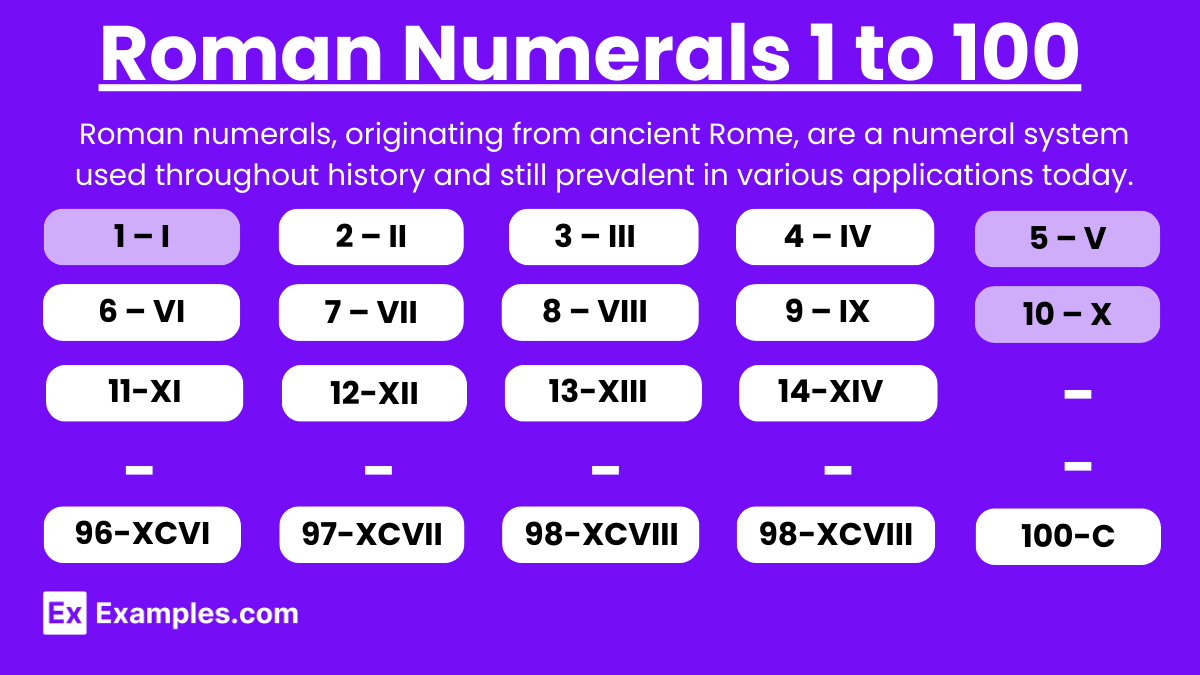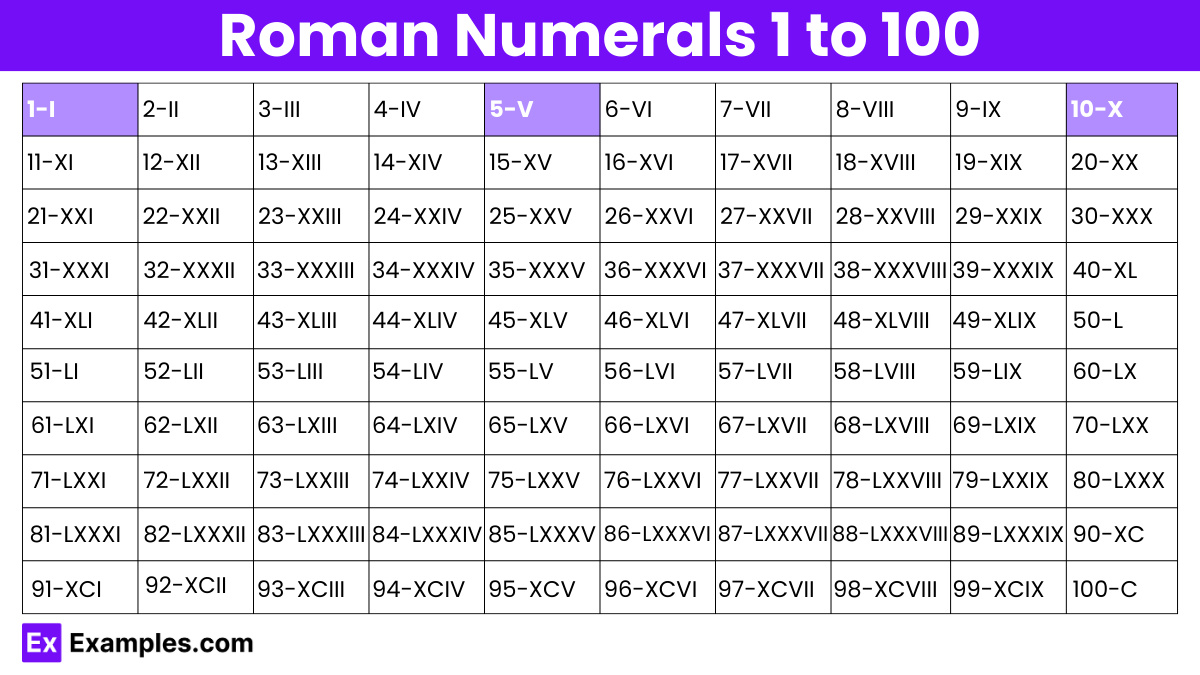What is the Roman numeral for 43?
XLIII
XLIV
XLII
LIII


Roman numerals, an ancient numerical system used by the Romans, are essential for understanding historical documents, clocks, and various modern applications. The Roman numeral system employs combinations of letters from the Latin alphabet: I for 1, V for 5, X for 10, L for 50, and C for 100, among others. For numbers 1 to 100, key numerals include I (1), V (5), X (10), L (50), and their combinations, such as II (2), IV (4), IX (9), XL (40), and XC (90). Understanding Roman numerals from 1 to 100 provides insight into ancient numbering methods and enhances one’s ability to interpret various contexts where these numerals are still in use today.
Download Roman Numerals 1 to 100 in PDF

Download Roman Numerals 1 to 100 in PDF
| 1-I | 2-II | 3-III |
|---|---|---|
| 4-IV | 5-V | 6-VI |
| 7-VII | 8-VIII | 9-IX |
| 10-X | 11-XI | 12-XII |
| 13-XIII | 14-XIV | 15-XV |
| 16-XVI | 17-XVII | 18-XVIII |
| 19-XIX | 20-XX | 21-XXI |
| 22-XXII | 23-XXIII | 24-XXIV |
| 25-XXV | 26-XXVI | 27-XXVII |
| 28-XXVIII | 29-XXIX | 30-XXX |
| 31-XXXI | 32-XXXII | 33-XXXIII |
| 34-XXXIV | 35-XXXV | 36-XXXVI |
| 37-XXXVII | 38-XXXVIII | 39-XXXIX |
| 40-XL | 41-XLI | 42-XLII |
| 43-XLIII | 44-XLIV | 45-XLV |
| 46-XLVI | 47-XLVII | 48-XLVIII |
| 49-XLIX | 50-L | 51-LI |
| 52-LII | 53-LIII | 54-LIV |
| 55-LV | 56-LVI | 57-LVII |
| 58-LVIII | 59-LIX | 60-LX |
| 61-LXI | 62-LXII | 63-LXIII |
| 64-LXIV | 65-LXV | 66-LXVI |
| 67-LXVII | 68-LXVIII | 69-LXIX |
| 70-LXX | 71-LXXI | 72-LXXII |
| 73-LXXIII | 74-LXXIV | 75-LXXV |
| 76-LXXVI | 77-LXXVII | 78-LXXVIII |
| 79-LXXIX | 80-LXXX | 81-LXXXI |
| 82-LXXXII | 83-LXXXIII | 84-LXXXIV |
| 85-LXXXV | 86-LXXXVI | 87-LXXXVII |
| 88-LXXXVIII | 89-LXXXIX | 90-XC |
| 91-XCI | 92-XCII | 93-XCIII |
| 94-XCIV | 95-XCV | 96-XCVI |
| 97-XCVII | 98-XCVIII | 99-XCIX |
| 100-C |
Creating a list of Roman numerals from I to C (1 to 100) involves a systematic approach to the Roman numeral system, where numbers are represented by combinations of letters. Starting from I (1) to C (100), each numeral follows specific rules of addition and subtraction, such as IV for 4 (I before V), IX for 9 (I before X), XL for 40 (X before L), and XC for 90 (X before C). This system, rooted in ancient Rome’s numerical conventions, persists in various contexts today, from academic studies of ancient history to practical applications in numbering chapters, outlining legal documents, and even indicating years in copyright dates.
Text prompt
Add Tone
10 Examples of Public speaking
20 Examples of Gas lighting
What is the Roman numeral for 43?
XLIII
XLIV
XLII
LIII
Which Roman numeral represents 77?
LXX
LXXVII
LXXVIII
LXXX
What is the Roman numeral for 29?
XXIX
XXVIII
XXX
XXVII
Which Roman numeral represents 94?
XCIV
XCI
XCIX
XCIII
What is the Roman numeral for 56?
LVI
LVII
LX
LV
Which Roman numeral represents 88?
LXXXVIII
LXXXVII
LXXXIX
LXXXVI
What is the Roman numeral for 62?
LXII
LXIII
LIX
LXXII
Which Roman numeral represents 34?
XXXIV
XXXIII
XXXVI
XXXV
Which Roman numeral represents 98?
XCVIII
XCVII
XCV
XCIX
What is the Roman numeral for 41?
XLI
XLII
XLIII
XL
Before you leave, take our quick quiz to enhance your learning!

